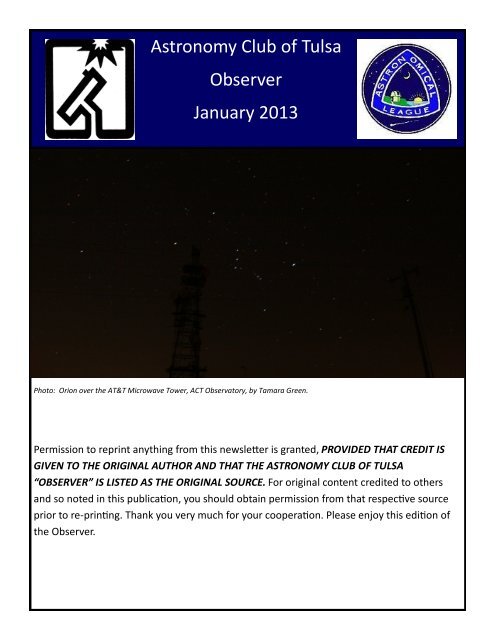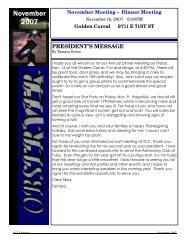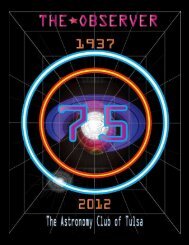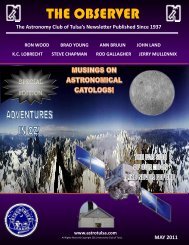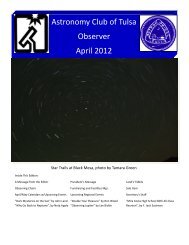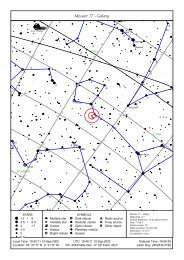Jan - Astronomy Club of Tulsa
Jan - Astronomy Club of Tulsa
Jan - Astronomy Club of Tulsa
You also want an ePaper? Increase the reach of your titles
YUMPU automatically turns print PDFs into web optimized ePapers that Google loves.
<strong>Astronomy</strong> <strong>Club</strong> <strong>of</strong> <strong>Tulsa</strong><br />
Observer<br />
<strong>Jan</strong>uary 2013<br />
Photo: Orion over the AT&T Microwave Tower, ACT Observatory, by Tamara Green.<br />
Permission to reprint anything from this newsletter is granted, PROVIDED THAT CREDIT IS<br />
GIVEN TO THE ORIGINAL AUTHOR AND THAT THE ASTRONOMY CLUB OF TULSA<br />
“OBSERVER” IS LISTED AS THE ORIGINAL SOURCE. For original content credited to others<br />
and so noted in this publication, you should obtain permission from that respective source<br />
prior to re-printing. Thank you very much for your cooperation. Please enjoy this edition <strong>of</strong><br />
the Observer.
Inside This Edition:<br />
Article/Item<br />
Page<br />
Calendar and Upcoming Events 3<br />
President’s Message, by Owen Green 4<br />
Treasurer’s and Membership Report, by John Land 5<br />
Astronomers’ Starlight Cocoa, Recipe by John Land 6<br />
The Secretary’s Stuff, by Tamara Green 7<br />
Astronomical League Analemma Program, by Brad Young 8<br />
NITELOG - Norway InTErurban Local Observing Group,<br />
By Tom H<strong>of</strong>felder 15<br />
NASA’s The Space Place Newsletter <strong>Jan</strong>/Feb 2013 23<br />
Where We Meet 26<br />
Officers, Board, Staff and Membership Info 27<br />
2
<strong>Jan</strong>uary 2013<br />
Sun Mon Tue Wed Thu Fri Sat<br />
1 2 3 4 Last Quarter<br />
5<br />
Public Star Party<br />
6 7 8 9 10 11 New Moon<br />
Members’ Night<br />
12<br />
Members’ Night<br />
13 14 15 16 17 18 1st Quarter 19<br />
20 21 22 23 24 25<br />
General Meeting<br />
26 Full Moon<br />
Sidewalk <strong>Astronomy</strong><br />
27 28 29 30 31<br />
UPCOMING EVENTS:<br />
Members’ Night Fri., <strong>Jan</strong>. 11 ACT Observatory 6:00 PM<br />
Members’ Night (backup) Fri., <strong>Jan</strong>. 12 ACT Observatory 6:00 PM<br />
General Meeting Fri., <strong>Jan</strong>. 25 TCC NE Campus 7:00 PM<br />
Sidewalk <strong>Astronomy</strong> Sat., <strong>Jan</strong>. 26 Bass Pro 6:00 PM<br />
Dates for February TBA<br />
3
President’s Message<br />
By Owen Green<br />
Greetings Fellow Stargazers!<br />
I hope everyone had a safe and good holiday season. At the start <strong>of</strong> the new year some<br />
people got new telescopes for Christmas. So, we had a meeting at <strong>Tulsa</strong> Air and Space Museum<br />
on Saturday and Sunday, <strong>Jan</strong>uary 5th and 6 th . We had 16 guests show up with their new<br />
scopes. I would like to thank Stan, Skip, Richard, Mandy, Michael, John and Tamara for being<br />
there. The time went VERY quickly, plus it was a lot <strong>of</strong> fun.<br />
Things I will be looking at this month: We will start with my favorite planet Jupiter, then the<br />
top crowd pleaser in my opinion, M42 The GREAT Orion Nebula, as well as the brightest star<br />
we can see from our plantet, (with the noted exception our Sun) the Dog Star Sirius and the<br />
constellation <strong>of</strong> Leo (yup this is my sign, so you can point to Leo and tell me "Here's your<br />
Sign!” :)<br />
This year we have three new first timers to the Officers and Board <strong>of</strong> ACT. I would like to welcome<br />
Lee Bickle as my Vice President, and Mandy Nothnagel and Jody Ray-Fleetwood to the<br />
Board.<br />
Owen Green<br />
President<br />
4
Treasurer’s and Membership Report<br />
By John Land<br />
I haven’t had time to do a full Treasurer Report <strong>of</strong> 2012. That will appear in the February Issue once all the<br />
annual reports and tax papers are completed.<br />
2012 was a good year for the club. We finished the year with 110 members ,<strong>of</strong> which 34 were new members.<br />
So far in 2013 we’ve picked up 4 new members!<br />
The website brought in 198 visitors added to our email lists<br />
Had a great turn out at the Telescope 101 classes. With 16 new contacts added.<br />
Our new members from 2012 are Scott Allen and Rusty Alford<br />
2013 new members are Carl Sluder, Ian Hudson, Linda Ghali, Hannah Thomas<br />
Dec 31 Year End accounts: Checking $2,253.39, Savings $ 7,009.68<br />
Investment account: Started 2012 at $ 15,305.62, Ended 2012 at $ 17,130.36 for a growth <strong>of</strong> 11.92%<br />
NEWS NOTE: Both Sky & Telescope and <strong>Astronomy</strong> have free Digital subscriptions available with print subscriptions<br />
or Digital subscriptions may be purchased separately.<br />
Contact their websites for details.<br />
Membership rates for 2013 will be as follows:<br />
Adults - $ 45 per year, includes Astronomical League Membership .<br />
Sr. Adult - $ 35 per year for those 65 or older, includes Astronomical League Membership.<br />
Students - $ 30 with League membership; Students $ 25 without League membership.<br />
Additional Family membership - $ 20 with voting rights and League membership, $ 15 with voting rights<br />
but without League Membership. The regular membership allows all members in the family to participate<br />
in club events, but only ONE Voting Membership and one Astronomical League membership.<br />
Join Online – Add or renew magazine subscriptions: http://www.astrotulsa.com/page.aspxpageid=16<br />
Magazine Subscriptions: If your magazines are coming up for renewal, try to save the mailing label or renewal<br />
form you get in the mail. Forms are available on the club website.<br />
<strong>Astronomy</strong> is $ 34 for 1 year or $ 60 for 2 years.<br />
www.astronomy.com<br />
To get the club discount you must go through the club group rate.<br />
Sky & Telescope is $33 / year<br />
Sky and Telescope also <strong>of</strong>fers a 10% discount on their products.<br />
www.skyandtelescope.com<br />
Note: You may renew your Sky & Telescope subscription Directly Online without having to mail in the subscriptions<br />
to the club. NEW SUBSCRIPTIONS must still be sent to the club treasurer.<br />
5
For those cold Winter’s nights at the telescope, a delightful recipe from John!<br />
Astronomer's Starlight Cocoa<br />
"One sip <strong>of</strong> this and you'll think you're in Chocolate<br />
Heaven"<br />
5 Cups Instant Milk<br />
1/2 Cup Hershey’s Cocoa Unsweetened powder<br />
16 oz. C<strong>of</strong>fee Creamer<br />
Large container Instant Cocoa Mix (16 to 30 oz size)<br />
Blend above ingredients thoroughly in a large covered<br />
container.<br />
Put 1/3 cup <strong>of</strong> powder in a ceramic or insulated cup.<br />
Add Hot Water while stirring it into the powder.<br />
Stir until all powder is dissolved then enjoy!<br />
Editor’s Note: And to go with the cocoa, The Food Network’s website has a recipe for homemade<br />
marshmallows! I have made these twice already and they are insanely good! It does not have to be<br />
the Holiday Season to enjoy these recipes. These are great for Messier Marathons! Here is a link<br />
to the recipe:<br />
http://www.foodnetwork.com/recipes/alton-brown/homemade-marshmallows-recipe/index.html<br />
6
The Secretary’s Stuff<br />
By Tamara Green<br />
Happy New Year Everyone!<br />
This edition <strong>of</strong> the newsletter will be out before our next general meeting, and we are still trying<br />
to hash out a date for our first board meeting <strong>of</strong> the year, so there are no minutes yet.<br />
However, I can tell you we had a really great time at the Telescopes 101 Workship at TASM on<br />
<strong>Jan</strong>uary 5th and 6th. We had a good turnout on Saturday the 5th, but not nearly as many<br />
came out to visit us on Sunday the 6th.<br />
Volunteers from our <strong>Club</strong> included myself, Owen, Mandy, Lee, Skip, Stan, Michael and John. If<br />
I missed anyone, I apologize. I was going by who I actually saw there and did not mean to<br />
slight anyone.<br />
I hope everyone had a good holiday season and look forward to working with all <strong>of</strong> you to<br />
make 2013 a great year for our <strong>Club</strong>.<br />
Don’t forget, if you have any articles, pictures, announcements, and what-not that you would<br />
like to see in upcoming editions <strong>of</strong> the newsletter, please send them to me at:<br />
astronomer.misstamara@yahoo.com, and I will put them in there!<br />
Also, if you have completed an observing program and would like to receive your certificate<br />
and pin, please email those to me at the above email address as well. I will forward your log<br />
work to the appropriate Astronomical League program chair.<br />
Clear Skies!<br />
Tamara<br />
7
ASTRONOMICAL LEAGUE ANALEMMA PROGRAM<br />
By Brad Young<br />
Overview<br />
This observing program came along at the right time for me. I had just had shoulder surgery and was unable<br />
to do anything with my left arm. This left me unable to lift binoculars or a telescope, so other observing programs<br />
were not available to me for a while. It was easy for me to construct a box as described on the AL<br />
website in order to begin measuring the analemma. With the assistance <strong>of</strong> my son, I was also able to install<br />
a metal bar in our backyard and nail a board to our fence in order to create a post that would cast a shadow<br />
that I could track. We began in early November 2011 to start tracking the motion <strong>of</strong> the sun via these two<br />
methods while I was stuck at home recuperating from the surgery. After some <strong>of</strong> the issues described below,<br />
I added a third method, with images taken each day and used to track the shadow <strong>of</strong> the building I<br />
work in and a statue nearby against the features below.<br />
Methods<br />
Box<br />
I did notice after a few days that I was not setting the box at exactly the same position in the driveway as I<br />
had started to originally. This caused me to have several bad readings during the first week and those have<br />
been discarded in the analysis. Once I did return to work, my first idea was to take the box with me and position<br />
it in the courtyard in front <strong>of</strong> our building each day at lunch. Unfortunately, there were two problems<br />
with this - one was consistently setting up at exactly local noon during the work day (a problem that would<br />
be repeated later with taking images). The other was the same problem I had run across at home with the<br />
box which was setting it pointing directly north the same way each day.<br />
I have to admit, it was also a little strange also carrying around and fidgeting with a strange box in the courtyard<br />
at lunchtime with a crowd <strong>of</strong> people around in front <strong>of</strong> a tower that is a quarter sized model <strong>of</strong> the<br />
twin towers in New York City. I certainly got a few strange looks and decided this was not going to work out<br />
in the long run. Eventually, I decided to use the box only at home on days <strong>of</strong>f.<br />
Post<br />
After a while, I noticed that the piece <strong>of</strong> metal that I had driven into the ground was not as stable as I hope<br />
so I stabilized it and was able to begin tracing the shadow <strong>of</strong> the bar more consistently. Meanwhile, as summer<br />
approached and the trees began to leaf up the post became unusable because the sun was so high that<br />
the trees cast their shadow and the post’s shadow was not visible. Around August 4, the sun's position had<br />
changed enough that I could begin to use the post again.<br />
8
Astronomical League Analemma Program, by Brad Young, Ct’d.<br />
Images<br />
The images themselves were <strong>of</strong> some interest in developing the best way forward. I decided to take a picture<br />
<strong>of</strong> the shadow <strong>of</strong> the building I work in each day and use that in conjunction with the box and post once<br />
I had returned to work, I was still not certain the box and post would be error-free and figured that the<br />
building wasn't going anywhere unlike my positioning <strong>of</strong> the box.<br />
Camera<br />
Once I determine the best place in my <strong>of</strong>fice to measure the shadow, I started taking pictures with my cell<br />
phone each day at local noon as described before. Again, taking this picture every day when the local time is<br />
12:24 p.m. was somewhat hindered by my work schedule. Once daylight saving time took effect and the<br />
proper time was 1:24 p.m. it became even more problematic. I decided to use s<strong>of</strong>tware downloaded to my<br />
cell phone in order to make the pictures run <strong>of</strong>f a timer and allow me to leave the phone in my <strong>of</strong>fice for the<br />
imaging. None <strong>of</strong> the timer programs that I downloaded were very useful and there was also the problem <strong>of</strong><br />
positioning the phone and exactly the same angle each day - problems I had already run into with the box at<br />
home.<br />
Webcam<br />
At this point, I determined to start using a webcam and found a cheap one that I could position at the back<br />
window. It was useful for imaging on a timer within its own operating s<strong>of</strong>tware. This caused me to learn how<br />
to set up a scheduled task in Windows and update the system clock more rigorously using the internet. It<br />
was these and other computer tasks that I had not come across before that added an additional educational<br />
experience with this program.<br />
For a while, everything ran smoothly. I used the webcam to take a picture <strong>of</strong> both the shadow <strong>of</strong> the building<br />
and this sculpture below, which is called “The Artificial Cloud” next to the “Center <strong>of</strong> the Universe” tourist<br />
spot in <strong>Tulsa</strong>. Ultimately, I discarded using the cloud shadow due to foreshortening in summer.<br />
But, soon enough, I ran into a new problem; my desktop computer would time out on occasion. Even though<br />
I had set up a scheduled task the security settings at work would cause it to be locked down at just the<br />
wrong moment. I was able to get around the security settings at first but then and new and even stricter policy<br />
was implemented and there was no way to avoid the time out.<br />
I brought up a separate, ancient computer just to run the webcam, running independently <strong>of</strong> the security<br />
programs associated with my work computer system. Somewhere about the same time, the shadow shifted<br />
enough that the webcam was not set at the right angle and I lost a few days <strong>of</strong> shadows. There are also a<br />
few days missed here and there when I was out <strong>of</strong> town and the security system on my work desktop shut<br />
me down. Even after I had moved <strong>of</strong>f <strong>of</strong> the workplace network I figured out that the old desktop I had<br />
brought in was not consistently running the scheduled task that I had set up. Working with the s<strong>of</strong>tware<br />
company for the webcam I was able to fix a few glitches with their s<strong>of</strong>tware and get things running more<br />
smoothly at the cost <strong>of</strong> a few more days here and there <strong>of</strong> images that were missed.<br />
9
Astronomical League Analemma Program, by Brad Young, Ct’d.<br />
Finally, one more timing problem surfaced. While I had been attached to the Internet I had been able to run<br />
a recurring update to correct the time on my computer each day. Once I was decoupled from the Internet<br />
the old computer consistently ran fast on the clock time causing a discrepancy between the image time and<br />
local noon. I wrote a short Excel spreadsheet to check against WWV time signals every few days and select<br />
the closest image to the one desired after taking into consideration the time correction. True to form, the<br />
first time corrections went the wrong way, and the images selected were too early.<br />
Math<br />
The math involved with plotting the analemma was fairly straightforward trigonometry. The methods used<br />
for each determination required by the program are available on the internet or your old Spherical Geometry<br />
textbook. Instructions for doing the program and building the box on the AL website, at:<br />
http://www.astroleague.org/Analemma_Introduction<br />
{Did you really think I was going to show you how to do the math}<br />
Measurements<br />
Results <strong>of</strong> the project are below, including my calculated values, sample plots, photos <strong>of</strong> the box and post<br />
analemmas, an example daily webcam shot, and the overall webcam plot on a Google Earth map.<br />
ANALEMMA PROGRAM SUMMARY RESULTS<br />
Activity Box Post BOK Actual<br />
1 Obliquity <strong>of</strong> Earth's Orbit 22.9 18.0 24.0 23.5<br />
Latitude <strong>of</strong> Observer 37.4 28.2 37.1 36.1<br />
2 Sun Path in Sky - See Graphs<br />
3 Equation <strong>of</strong> Time - See Graphs<br />
4 Eccentricity <strong>of</strong> Earth's Orbit 0.0146 0.0147 0.0146 0.0167<br />
10
Astronomical League Analemma Program, by Brad Young, Ct’d.<br />
11
Astronomical League Analemma Program, by Brad Young, Ct’d.<br />
12
Astronomical League Analemma Program, by Brad Young, Ct’d.<br />
13
Astronomical League Analemma Program, by Brad Young, Ct’d.<br />
Results<br />
The results were not as accurate as I had hoped, but they do provide some idea <strong>of</strong> what the analemma looks<br />
like. The major error appears to be in time, with minor errors introduced by measurement <strong>of</strong> distance. This is<br />
certainly historically predictable; accurate timekeeping is one critical reason for deriving the EoT in the first<br />
place. The three methods had their problems as already mentioned above, but the method I’d hoped would<br />
be most accurate (BOK) suffered from another unforeseen one – map projection. I suppose I could have<br />
painted spots on the parking lot, but that seemed more risky than running around with a strange box!<br />
Probably the most important lesson I was reminded <strong>of</strong> is that experiments can be messy. Even using three<br />
methods did not negate the systemic errors that <strong>of</strong>ten affect empirical data. I did learn a few things about<br />
computer time updates and using a webcam. I also gained a new respect for the ancient astronomers that<br />
first began to measure the analemma and derive Earth’s orbital details from it.<br />
14
*NITELOG - Norway InTErurban Local Observing Group*<br />
by Tom H<strong>of</strong>felder, via Email Message<br />
Wow, it's 2013 already Who ordered that!!! Anyway, Happiest <strong>of</strong> New<br />
Years to all! Starting <strong>of</strong>f with a bang - if <strong>Jan</strong>uary is any indication,<br />
it's going to be a great year for astronomy!<br />
*OBSERVING:* <strong>Jan</strong> 7th, 7:30 PM, at the Twitchell Observatory, which is the<br />
reason the first date noted on the spreadsheet is the 7th, instead <strong>of</strong> the<br />
5th as it would have been in previous "editions." (If clear, I plan to set<br />
up our C14.) If anyone else plans any observing anywhere on any other<br />
days, and would like some company, I'm hoping this email will provide the<br />
means <strong>of</strong> coordinating other sessions in Maine. (Not just this month.)<br />
*COMETS:* 2012 K5 (LINEAR) could be interesting. Things to note: 1)<br />
predicted magnitudes are all over the place, 2) on the night <strong>of</strong> the 7th it<br />
will coincidentally be in a binocular field with one <strong>of</strong> the listed deep sky<br />
objects, open cluster NGC 1647, and 3) it is zipping right along, moving<br />
more than 3 degrees per day, thus the chart for that evening. For up to<br />
date magnitudes these two sites can be helpful:<br />
http://www.aerith.net/comet/weekly/current.html<br />
http://www.observatorij.org/cobs/<br />
*PLANETS:* Jupiter rises around 2 PM on the first and doesn't set until<br />
after 4 AM, so is in the sky a good chunk <strong>of</strong> the night. By the end <strong>of</strong> the<br />
month it <strong>of</strong> course sets about two hours earlier. Note there are four<br />
events (bold) in the jup.jan file when the red spot and a moon shadow<br />
should be visible at the same time. (Both are listed for the evening <strong>of</strong><br />
the 7th, however it will be difficult to see them simultaneously.) Saturn<br />
begins to get serious about showing itself, but still doesn't rise until<br />
after midnight (12:30) on the 31st.<br />
*DWARF PLANET*: If you've never seen one (in this case one a.k.a. an<br />
asteroid), you might want to get a glimpse <strong>of</strong> Ceres. Chart gives locations<br />
(tip <strong>of</strong> arrow) from the 5th thru the 14th, when the magnitude drops from<br />
7.2 to 7.5. And if you really want to get crazy, go for a second asteroid,<br />
Vesta. Locations for the same dates are shown on the comet chart; Vesta's<br />
mag will then range from 7.0 to 7.2.<br />
15
*NITELOG - Norway InTErurban Local Observing Group*, by Tom H<strong>of</strong>felder, Ct’d.<br />
*STARS:* Three carbons with blue minus visual mags <strong>of</strong> 3.2 to 3.6; maybe not<br />
red enough to knock your socks <strong>of</strong>f completely, but partial removal could<br />
result. The multiple stars include my favorite, 40b Eri, whose components<br />
are 9.5 and 11th mag, so obviously not my fave due to appearance. Not only<br />
is it a unique combination <strong>of</strong> a red dwarf and a white dwarf, but it is the *<br />
ONLY* white dwarf easily seen in small scopes. And the Trapezium, which<br />
normally wouldn't be listed (most objects are ones you may not have seen,<br />
which is why M1 and M42 are not there), is included for the challenge <strong>of</strong><br />
seeing how many <strong>of</strong> the dimmer stars (first attachment) can be seen in your<br />
scope. (Note: crank up the power for that, under a relatively steady sky.)<br />
*THE GOOD STUFF:* Five open clusters (one a Messier), one (the only<br />
winter) globular (also a Messier), two planetaries - one bright, one not<br />
so much, four diffuse nebulae and four galaxies, the most distant (known)<br />
being 90 million ly away. Couldn't find a distance for the NGC 1611 group,<br />
but it is at least 100 million and possibly 150 based on size. And let's<br />
not forget Kemble's Cascade, a lovely sight in binocs or wide field scopes,<br />
being a 2.5 degree long line <strong>of</strong> about 15 stars.<br />
*SUPERNOVA: *Last and definitely not least, how <strong>of</strong>ten do you get to see a<br />
single star 65 million light years away (OK, the bang actually happened<br />
long ago in a galaxy far far away, not this <strong>Jan</strong>uary.) SN 2012ht, a type Ia<br />
in NGC 3447, recently attained a magnitude <strong>of</strong> 12.8. It should remain<br />
around that value for a couple weeks, so - if the limiting magnitudes are<br />
correct in the Trapezium info - an 8 inch would be adequate for detection.<br />
Located in eastern Leo, viewing would commence around 10 PM on the 7th.<br />
*<br />
QUESTIONS:* As always, questions and comments are welcome!<br />
Tom H.<br />
*Come with me now, Pilgrim <strong>of</strong> the stars,<br />
For our time is upon us and our eyes<br />
shall see the far country<br />
and the shining cities <strong>of</strong> infinity* ~ Robert Burnham, Jr.<br />
16
*NITELOG - Norway InTErurban Local Observing Group*, by Tom H<strong>of</strong>felder, Ct’d.<br />
1/7 1/12<br />
SS CTE NTE ATE MR SS CTE NTE ATE MS<br />
16:20 16:53 17:29 18:04 02:40 16:26 16:58 17:34 18:09 17:50<br />
Comet ra dec star n/s e/w n/s/day e/w/day mag 1 mag 2 uran # date*<br />
C/2012 K5 (LINEAR) 04 57.5 +18 21 Tau 1. 7 N 5.3 E 3.0 S 1.5 W 8 11.0 134 1/7<br />
C/2012 K5 (LINEAR) 04 32.0 +06 06 Ori 0.4 N 4.8 W 1.8 S 0.9 W 8 11.5 179 1/12<br />
1 from http://www.aerith.net/comet/futuren.html<br />
*at 7 PM<br />
2 from http://www.minorplanetcenter.net/iau/Ephemerides/<br />
Comets/<br />
Object (Type) ra dec star n/s e/w<br />
Mag*/(#<br />
<strong>of</strong> Stars)<br />
Size (')/<br />
Sep (")<br />
Spect/ M#<br />
or H#<br />
Dist (ly)<br />
Urano I<br />
Page<br />
Comment<br />
[B-V] (optimum x)<br />
W Ori 05 05.4 +01 11 Ori 1.2 S 2.8 E 6.5-10 C 224 B-V=3.6<br />
TX Aur 05 09.1 +39 00 Aur 2.2 S 0.5 E 8.5-9.2 C 65 B-V=3.2<br />
Y Tau 05 45.7 +20 42 Tau 0.4 S 1.9 E 7.1-9.5 CII 136 B-V=3.4<br />
40 Eri ( ) 04 15.3 -07 39 Ori 0.5 N 14.5 W 4.5, 9.5 83 K1 16 268 (6)<br />
40b Eri --- --- --- --- --- 9.5, 11 7.6 dA,dM4 16 268 (65)<br />
32 Eri 03 54.3 -02 57 prev 4.7 N 5.2 W 5, 6 6.9 G8, A1 222 (70)<br />
04 22.4 +20 48 Tau 1.6 N 1.5 W 6, 9 2.0 gM0, A0 133 (ni) (240)<br />
Ori 05 14.5 -08 12 --- --- --- 0, 7 9.4 B8, B9 900 270 (50)<br />
Ori 05 35.3 -05 23 --- --- --- 5,7,7,8 13,13,15 O6,B0,A7 1300 271<br />
Ori 05 40.8 -01 57 --- --- --- 2, 5.5 2.3 B0, 1600 226 (220)<br />
NGC 1502 (OC) 04 07.8 +62 20 Per 10.0 N 0.1 E (15) 20 H47-7 3750 18<br />
Kemble's Cascade 03 59 +62 50 prev 0.5 N 1.0 W (15) 150 --- 18<br />
NGC 1501 (PN) 04 07.0 +60 55 (1502) 1.4 S 0.1 W 11.5 0.9 H53-4 13,600 18<br />
NGC 1528* (OC) 04 15.4 +51 13 Per 0.9 N 1.3 E (80) 18 H61-7 2,800 39<br />
NGC 1532 (SBb) 04 12.1 -32 52 41 Eri 0.9 N 1.2 W [13.6] 11X3 --- 50M 356 +1531<br />
NGC 1535 (PN) 04 14.3 -12 44 Eri 0.8 N 4.0 E 9.6 0.9 H26-4 2150 268 1538 (GX) 0.5 S<br />
NGC 1611* (S0a) 04 33.1 -04 18 Eri 0.9 S 0.8 W [13.5] 2X0.6 H586-3 223 1609/12/13<br />
NGC 1647 (OC) 04 45.9 +19 07 Tau 2.5 N 2.5 E (30) 40 H8-8 3600 134<br />
NGC 1746 (OC) 05 03.8 +23 46 Tau 0.8 N 4.9 E (60) 40 --- 3250 134<br />
NGC 1788* (DN) 05 06.9 -03 20 Eri 1.8 N 0.2 W 5X3 H32-5 3250 225<br />
NGC 1904 (GC) 05 24.2 -24 31 Lep 3.8 S 0.9 W 7.7 9.6 M79 43K 315<br />
NGC 1886* (Sbc) 05 21.8 -23 49 prev 0.7 N 0.6 W [12.9] 3.1X0.4 --- 90M 315<br />
NGC 1931* (DN) 05 31.4 +34 15 Tau 5.5 N 1.0 E 6 H261-1 8150 97 M36 0.1 S/1.0 E<br />
NGC 1964* (SBb) 05 33.4 -21 57 Lep 1.2 S 1.2 E [13.2] 5X2 H21-4 70M 315<br />
NGC 1999* (DN) 05 36.4 -06 43 Ori 0.9 S 0.2 E 2 H33-4 1300 271<br />
NGC 2024* (DN) 05 41.7 -01 51 Ori 0.1 N 0.3 E 30 H28-5 1300 226<br />
NGC 2099 (OC) 05 52.3 +32 33 Aur 4.7 S 1.6 W (150) 15 M37 4700 98<br />
*DSS image<br />
*[Surf Brtnss for<br />
GX's] -<br />
ni=shown but<br />
mag per square<br />
arcmin<br />
not identified<br />
17
*NITELOG - Norway InTErurban Local Observing Group*, by Tom H<strong>of</strong>felder, Ct’d.<br />
Comet 2012 K5 LINEAR Chart<br />
Ceres Chart<br />
18
*NITELOG - Norway InTErurban Local Observing Group*, by Tom H<strong>of</strong>felder, Ct’d.<br />
Editor’s Note: Below is the portion <strong>of</strong> the Jupiter Spreadsheet for <strong>Jan</strong>. 1-15, 2013. The whole was too large to<br />
fit all onto this page. <strong>Jan</strong>. 16-31 next page.<br />
JUPITER IN JAN 2013 (EST)<br />
DATE GRST* I SHAD E SHAD G SHAD C SHAD<br />
1 19:00-21:10<br />
2 21:07<br />
3 16:58<br />
4 22:45<br />
5 18:37<br />
6<br />
7 20:15 02:26-04:37<br />
17:10-<br />
19:34<br />
8 20:55-23:06<br />
9 21:53<br />
10 17:45 17:40-19:52<br />
11 23:32<br />
12 19:23<br />
13<br />
14 21:01<br />
19:46-<br />
22:10<br />
15 16:53 22:50-<br />
19
*NITELOG - Norway InTErurban Local Observing Group*, by Tom H<strong>of</strong>felder, Ct’d.<br />
Below is the spreadsheet for <strong>Jan</strong>. 16-31.<br />
16 22:40 01:01<br />
17 18:31 17:19-19:30 21:41-23:54<br />
18<br />
19 20:10<br />
20<br />
21 21:48 22:22-<br />
22 17:40 00:46<br />
23 23:27 00:46-02:57<br />
24 19:18 19:15-21:26<br />
25 01:41-03:55<br />
26 20:57<br />
27<br />
28 22:35<br />
29 18:27 00:58-03:22<br />
30<br />
31 20:07 21:10-23:21<br />
*Time <strong>of</strong> transit; spot is visible +/- one hour<br />
20
*NITELOG - Norway InTErurban Local Observing Group*, by Tom H<strong>of</strong>felder, Ct’d.<br />
Trapezium Chart<br />
21
*NITELOG - Norway InTErurban Local Observing Group*, by Tom H<strong>of</strong>felder, Ct’d.<br />
Good Stuff!<br />
Supernova!<br />
22
For Young Stargazers<br />
Check out these fun websites from NASA!<br />
http://climate.nasa.gov/kids<br />
http://scijinks.gov<br />
http://spaceplace.nasa.gov<br />
25
Where We Meet:<br />
TCC Northeast Campus, 3727 E. Apache St., Student Union Bldg. 2, Room 1603<br />
There is PLENTY <strong>of</strong> parking, lighting and security on this campus.<br />
To get to TCC NE Campus, take the Harvard Exit <strong>of</strong>f <strong>of</strong> Hwy. 11 (Gilcrease Expressway).<br />
Go south for about 1/2 mile to the campus located at the corner <strong>of</strong> N. Harvard and<br />
Apache. Turn east on Apache and take the entrance in front <strong>of</strong> Bldg. 3 (the large round<br />
building). Then turn right and park in front <strong>of</strong> Student Union Building #2. Room 1603 is<br />
just <strong>of</strong>f <strong>of</strong> the lobby.<br />
Google-type driving direction map at http://www.tulsacc.edu/13273/<br />
We hope to see you there!<br />
Our General Meeting will be on Friday, <strong>Jan</strong>uary 25 at 7:00 PM.<br />
Program: TBA<br />
26
CLUB OFFICERS<br />
MEMBERSHIP INFORMATION<br />
PRESIDENT OWEN GREEN 918-851-8171<br />
VICE PRESIDENT LEE BICKLE 918-872-8744<br />
SECRETARY TAMARA GREEN 918-851-1213<br />
TREASURER JOHN LAND 918-695-3195<br />
BOARD MEMBERS AT LARGE<br />
STAN DAVIS<br />
stan.home@cox.net<br />
MICHAEL BLAYLOCK<br />
quaga53@cox.net<br />
MANDY NOTHNAGEL<br />
sleepinallday@gmail.com<br />
CHRISTOPHER PROCTOR<br />
act_maint@astrotulsa.com<br />
JODY RAY-FLEETWOOD<br />
oubre70@yahoo.com<br />
TONY WHITE<br />
tony@astrotulsa.com<br />
APPOINTED STAFF<br />
NEWSLETTER EDITOR TAMARA GREEN 918-851-1213<br />
FACILITIES MANAGER CHRISTOPHER PROCTOR 918-810-6210<br />
MEMBERSHIP CHAIRMAN JOHN LAND 918-695-3195<br />
OBSERVING CO-CHAIRS OWEN & TAMARA GREEN 918-851-1213<br />
GROUP DIRECTOR JENNIFER JONES 918-629-8732<br />
PR/OUTREACH/SIDEWALK ASTRONOMY OWEN GREEN 918-851-8171<br />
NIGHT SKY NETWORK TERESA DAVIS 918-637-1477<br />
WEBMASTER JENNIFER JONES 918-629-8732<br />
FUNDRAISING CHAIR CATHERINE KAHBI 918-230-8480<br />
MEMBERSHIP RATES FOR 2012 WILL BE AS FOLLOWS:<br />
Adults - $45 per year. Includes Astronomical League membership.<br />
Senior Adults - $35 per year. For those aged 65 and older. Includes<br />
Astronomical League membership.<br />
Students - $30 per year. Includes Astronomical League Membership.<br />
Students - $25 per year. Does not include Astronomical League<br />
membership.<br />
The regular membership allows all members <strong>of</strong> the family to participate<br />
in <strong>Club</strong> events, but only ONE voting membership and ONE Astronomical<br />
League membership per family.<br />
Additional Family Membership - $15 with <strong>Astronomy</strong> <strong>Club</strong> <strong>of</strong> <strong>Tulsa</strong><br />
voting rights, $20 with <strong>Club</strong> voting rights and Astronomical League<br />
membership.<br />
THOSE WISHING TO EARN ASTRONOMICAL LEAGUE OBSERVING CER-<br />
TIFICATES NEED TO HAVE A LEAGUE MEMBERSHIP.<br />
MAGAZINES:<br />
<strong>Astronomy</strong> is $34 for one year or $60 for 2 years.<br />
www.astronomy.com<br />
Sky & Telescope is $33 per year.<br />
www.skyandtelescope.com<br />
Sky & Telescope <strong>of</strong>fers a 10% discount on their products.<br />
If you are an existing S&T subscriber, you can renew directly with S&T<br />
at the same <strong>Club</strong> rate. Both S&T and <strong>Astronomy</strong> now have digital<br />
issues for computers, iPads and smart phones.<br />
ONLINE REGISTRATION<br />
We now have an automated online registration form on the website for new<br />
memberships, membership renewals and magazine subscriptions. Just simply<br />
type in your information and hit “send” to submit the information. You can then<br />
print a copy <strong>of</strong> the form and mail it in with your check. At this time we do not<br />
have an option for credit card payment, but we may explore that at a later time.<br />
Link: http://www.astrotulsa.com/<strong>Club</strong>/join.asp<br />
27
THE ASTRONOMY CLUB OF TULSA INVITES YOU TO<br />
MAKE PLANS THIS WINTER TO JOIN US AT AN ASTRONOMY CLUB OF TULSA STAR PARTY!<br />
OPEN TO THE PUBLIC<br />
For more information please visit www.astrotulsa.com.<br />
The Observer is a publication by the <strong>Astronomy</strong> <strong>Club</strong> <strong>of</strong> <strong>Tulsa</strong>. The <strong>Astronomy</strong> <strong>Club</strong> <strong>of</strong> <strong>Tulsa</strong> is a 501C 3 non-pr<strong>of</strong>it organization<br />
open to the public. The <strong>Club</strong> started in 1937 with the single mission to bring the joy and knowledge <strong>of</strong> astronomy<br />
to the community <strong>of</strong> <strong>Tulsa</strong>, OK and the surrounding area. Today our mission remains exactly the same. We<br />
travel to local schools, churches and many other venues with scopes and people to teach. Our observatory is located<br />
in Mounds and many public programs are <strong>of</strong>fered there. To join the <strong>Astronomy</strong> <strong>Club</strong> <strong>of</strong> <strong>Tulsa</strong> please visit<br />
www.astrotulsa.com where you will find all the information necessary to become a member.<br />
28


